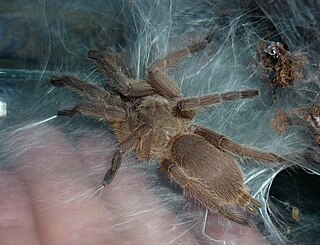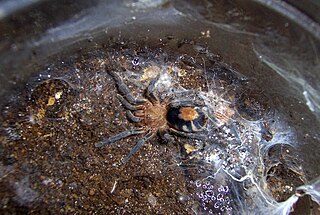
Table Mountain National Park, previously known as the Cape Peninsula National Park, is a national park in Cape Town, South Africa, proclaimed on 29 May 1998, for the purpose of protecting the natural environment of the Table Mountain Chain, and in particular the rare fynbos vegetation. The park is managed by South African National Parks. The property is included as part of the UNESCO Cape Floral Region World Heritage Site.

Pterinochilus murinus or the orange baboon tarantula, is a nocturnal spider in the family Theraphosidae that was first described in 1897 by Reginald Innes Pocock. This species is found in Angola, as well as central and southern Africa. It is a member of the subfamily Harpactirinae, baboon spiders.
Harpactira gigas, sometimes called the common baboon spider, is a species of spider belonging to the family Theraphosidae. It is found in South Africa from Western Cape Province north to Limpopo Province.

Megaphobema robustum, known as the Colombian giant tarantula or Colombian giant redleg, was first described by Anton Ausserer in 1875. Found in the tropical rainforests of Colombia and Brazil near logs, it has a span of 6 to 8 inches and will eat crickets, other large insects, small lizards and mice.

Ephebopus cyanognathus, known as the blue fang tarantula, is a species of tarantula. It is endemic to French Guiana. It was first described by Rick C. West and Samuel D Marshall in 2000, and is somewhat commonly kept as pets. As it common name may suggest, they have magnificent blue chelicerae, cyano meaning blue and gnathus meaning jaw. This tarantula is a burrowing spider, though spiderlings of this species have been observed to be semi-arboreal.
Cardiopelma is a genus of spiders in the family Theraphosidae. It was first described in 1999 by Vol. As of 2017, it contains only one species, Cardiopelma mascatum, known only from Mexico, in the state of Oaxaca.

Encyocratella is a monotypic genus of Tanzanian tarantulas containing the single species, Encyocratella olivacea, also known as the Tanzanian black and olive baboon spider. It was first described by Embrik Strand in 1907, and is found in Tanzania.

Harpactira pulchripes, also known as the golden blue-legged baboon spider, is a bright yellow-bodied and metallic blue-legged tarantula found in South Africa. It was first described by Reginald Innes Pocock in 1901. It is a very highly desired tarantula in the European and American tarantula keeping hobby. Its specific name pulchripes is derived from Latin "pulchri" meaning beautiful, and "pes" meaning feet, forming the name beautiful feet.

Thrixopelma ockerti, commonly known as the Peruvian Flame Rump or Flame Rump Tree Spider, is a species of tarantula and the type species of the genus Thrixopelma. It is endemic to Peru and was first described by Gunter Schmidt in 1994. It is named ockerti after the collector Roland Ockert.

Phormictopus auratus, commonly known as the Cuban bronze tarantula, is a species of tarantula endemic to Cuba. It is found in the provinces of Camagüey, Las Tunas and Holguín. It was first described by David Ortiz and Rogério Bertani in 2005, and was named after golden hairs found in this species, auratus meaning golden in Latin.

Ceratogyrus marshalli, also known as Straight Horned Baboon or Great Horned Baboon Tarantula, is a species of tarantula from the genus Ceratogyrus. It is found in Zimbabwe and Mozambique. It was first described by Reginald Innes Pocock in 1897, as half of the Ceratogyrus genus, they own a impressive horn in the carapace.

Monocentropus balfouri is a tarantula in the Monocentropus genus, it was first described by Reginald Innes Pocock in 1897. This tarantula is also called Socotra Island Blue Baboon Tarantula, usually shortened to Blue Baboon Tarantula. This spider is named after its collector Isaac Bayley Balfour. It is found in Socotra Island, hence the common name. This tarantula is terrestrial and an opportunistic burrower. Like many tarantulas, M. balfouri can be kept as a pet, although it is not a beginner species.
Aphonopelma moreae otherwise known as Mexican jade fuego tarantula is a species of a tarantula first described by Andrew Smith in 1995. It is named after Barbara Moore, who is the President of the American Arachnological Society. As its common name may suggest it is found in Mexico, in the state of Sonora, south of Yécora. This tarantula is sometimes kept as pet, though the price is usually very high. This is a terrestrial tarantula, which sometimes digs intricate burrows.
Phrixotrichus scrofa is a tarantula spider, commonly known as the Chilean copper, Chilean pink burst or Chilean violet tarantula. It was first described by Juan Ignacio Molina in 1782. Its synonyms include Phrixotrichus auratus, Paraphysa scrofa, and possibly Phrixotrichus chilensis. It is native to Chile and Argentina, inhabiting mainly arid forests, and is kept as a pet somewhat commonly.
Acanthoscurria insubtilis also known as the Bolivian black velvet tarantula, is a spider which was first described by Eugène Simon in 1892. It is found in Bolivia, with some reports also stating in Brazil, though it is mainly in the Bolivian Rainforests.
Pterinochilus lugardi also known Grey starburst baboon, Dodoma baboon, Fort hall baboon or Tanzanian blonde baboon tarantula is a tarantula first described by Reginald Innes Pocock in 1900. They are found all over Southern and Eastern Africa, of course excluding Madagascar.
Eucratoscelus pachypus also known as the Tanzania stout leg baboon tarantula or the stout leg tarantula, was first described by Gunter Schmidt and Volker von Wirth in 1990. It is found in Tanzania, hailing from arid parts, and is an obligate burrower.
Bonnetina minax also known as Mexican copperhead tarantula, is a tarantula which was first described by David Ortiz and Oscar F. Francke in 2017. It is found in Mexico, in the state of Michoacán, and is named after the Latin adjective "minax" that means menacing, as the red found in is carapace is usually aposematic coloration.

Chilobrachys huahini also known as the Asian fawn, Hauhini bird spider or Hauhini birdeater tarantula is a tarantula which was first described in 1996 by Gunter Schmidt and Siegfried Huber. It is named after Hua Hin, Thailand as it is found there.

Cyriocosmus perezmilesi otherwise known as the Bolivian dwarf beauty tarantula is a spider which was first described by Radan Kaderka in 2007. It was named in honor of Dr. Fernando Pérez-Miles, and is a fossorial tarantula. As its common name aptly states it is found in Bolivia.












